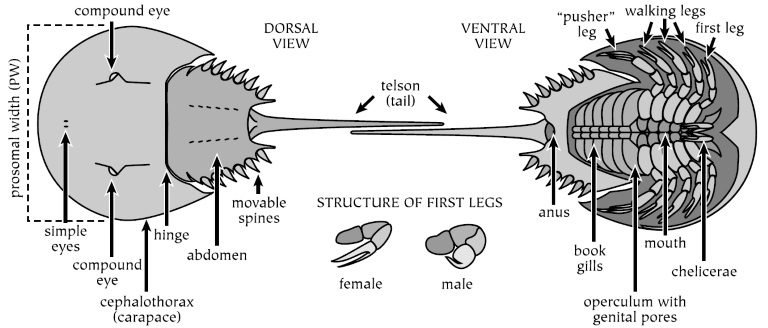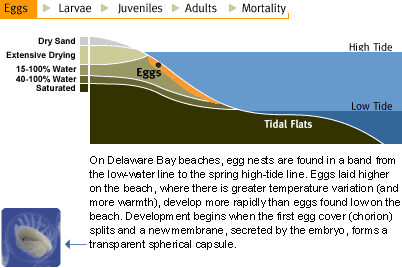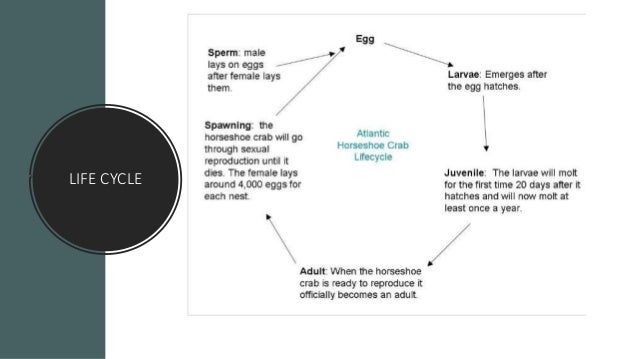Horseshoe crabs have survived multiple mass extinction events and outlived the dinosaurs but now their time may be coming to an end From 2004 to 2017 along the US Atlantic coast an average of approximately 417700 crabs were harvested and bled annually by the biomedical industry ASMFC staff told The New Economy. The horseshoe crab reaches maturity at 8-9 years for males and 10-11 years for females.
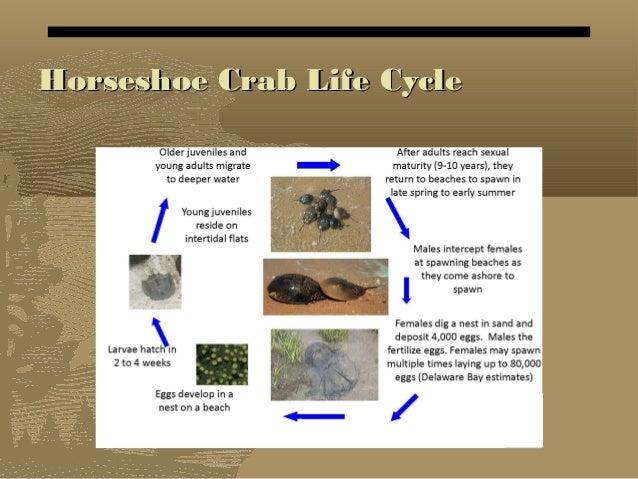 Nps Presentaion On Horshoe Crabs In Jamaica Bay
Nps Presentaion On Horshoe Crabs In Jamaica Bay
Horseshoe crabs go through 16 or 17 molts during their development.

Horseshoe crab life cycle. As spring approaches the crabs move en masse toward the beaches to prepare for spawning. The mating season is determined by light censers on the body of the crab which detect a change in hours of light per day. Juvenile horseshoe crabs generally spend their first and second summer on the intertidal flats feeding before the daytime low tide and burrowing in the sand for the rest of the day.
Spawning typically coincides with the high tides associated with both the new and the full moon. In comparison the males reach maturity at their sixteenth molt and are about 8 or 9 years old. Life Cycle of the Horseshoe Crab.
Scroll over the timeline below for a quick look at the horseshoe crabss life stages. Life Cycle of the Horseshoe Crab - YouTube. The overall goal of this chapter is to provide an overview of the life history cycle of the American horseshoe crabs Limulus polyphemus that reside in the Great Bay Estuary New Hampshire USAGreat Bay horseshoe crabs generally spawn during high tides in the spring.
Since the horseshoe crabs life cycle depends on spawning peaks during new and full moons these five dorsal eyes are vital for the horseshoe crabs reproduction. Both temperature and tide play a role in stimulating breeding. By determining the age of these univalves the age of the horseshoe crab can also be established.
Once horseshoe crabs are ten years old they are mature and therefore a breeding adult. Over the next 10 years or so the juvenile horseshoe crabs will molt and grow. Adults spend the winter in deep bay waters and off-shore areas.
Therefore the lifespan of horseshoe crabs may be 17 to 19 years in the northern part of their range accepting the estimate of 9 to 11 years to reach sexual maturity Shuster 1950. After hatching horseshoe crabs spend their first few years of life on the tidal flats and move out farther from shore as they get older. At around 10 years of age horseshoe crabs reach adulthood.
Since horseshoe crabs have a hard shell they must molt to grow. Horseshoe Crab Life Cycle The spawning season of the Atlantic horseshoe crab varies by location. Because females are much larger than males they molt about one or two more times reaching maturity around 10 or 11 years old.
Two year old horseshoe crabs raised in Maryland classrooms. As it gets closer to the adult stage it will move out to deeper waters. LIFE CYCLE Spawning takes place March to July peaking May through June.
During this stage of its life it spends the first couple years in the intertidal flats. If playback doesnt begin shortly try restarting your. During evening high tides when the moon is full or new adult horseshoe crabs emerge from their muddy beds to crawl up onto sandy protected beaches to mate and lay eggs.
The peak of the mating season is synchronized with the moon cycles of late May and early June. Eggs with embryos visible. On males these legs are modified int a claw to grasp onto the female during reproduction.
The life cycle of the horseshoe crab looks like this. At maturity mortality is low and the horseshoe crab stops molting. At a young age the horseshoe crab will molt many times throughout the first year of its life.
Cape May NJ- Horseshoe crab life cycle was a topic I was asked to cover at an event at the Aquaculture Innovation Center at Rutgers University last Friday. Most studies have concluded that there are at least 18 growth stages in the horseshoe crab lifecycle that encompass various stages of embryo larvae juvenile and adult. If you didnt know it existed it is tucked behind the Channel apartments just off Bayshore road alongside the Cape May canal-in Lower Township.
Like birds horseshoe crabs also have gizzards for grinding food before it reaches their stomachs. The second pair of legs on a horseshoe crab are called the pedipalps. The molting process requires shedding small exoskeletons in exchange for larger shells.
Like many animals horseshoe crabs exhibit sexual dimorphism. Two eyes on the horseshoe crabs underside near the mouth help it keep its orientation while its swimming. Trilobite larva surrounded by eggs.
The horseshoe crab increases in size by a rapid uptake of water. As the crab ages it will molt about once a year. Lifecycle of the Horseshoe Crab.
The horseshoe cabs spawns at high tide when the water is warmer than about 60F usually between spring and fall.
 Environmental Exposure Of Atlantic Horseshoe Crab Limulus Polyphemus Early Life Stages To Essential Trace Elements Sciencedirect
Environmental Exposure Of Atlantic Horseshoe Crab Limulus Polyphemus Early Life Stages To Essential Trace Elements Sciencedirect
 Limulus Polyphemus Schaul 2010 Outline Horseshoe Crab Overview Background Physical Features Reproduction Nest Sites Life Cycle Endangered Why Care Ppt Download
Limulus Polyphemus Schaul 2010 Outline Horseshoe Crab Overview Background Physical Features Reproduction Nest Sites Life Cycle Endangered Why Care Ppt Download
 Horseshoe Crab Reproduction Life Cycle Study Com
Horseshoe Crab Reproduction Life Cycle Study Com
 Three Decades Of Horseshoe Crab Rearing A Review Of Conditions For Captive Growth And Survival Carmichael 2012 Reviews In Aquaculture Wiley Online Library
Three Decades Of Horseshoe Crab Rearing A Review Of Conditions For Captive Growth And Survival Carmichael 2012 Reviews In Aquaculture Wiley Online Library
 The Secret Lives Of Horseshoe Crabs Cool Green Science
The Secret Lives Of Horseshoe Crabs Cool Green Science
 Horseshoe Crab Reproduction Life Cycle Study Com
Horseshoe Crab Reproduction Life Cycle Study Com
 Life Cycle Of A Horseshoe Crab Miniature Model Righttolearn Com Sg
Life Cycle Of A Horseshoe Crab Miniature Model Righttolearn Com Sg
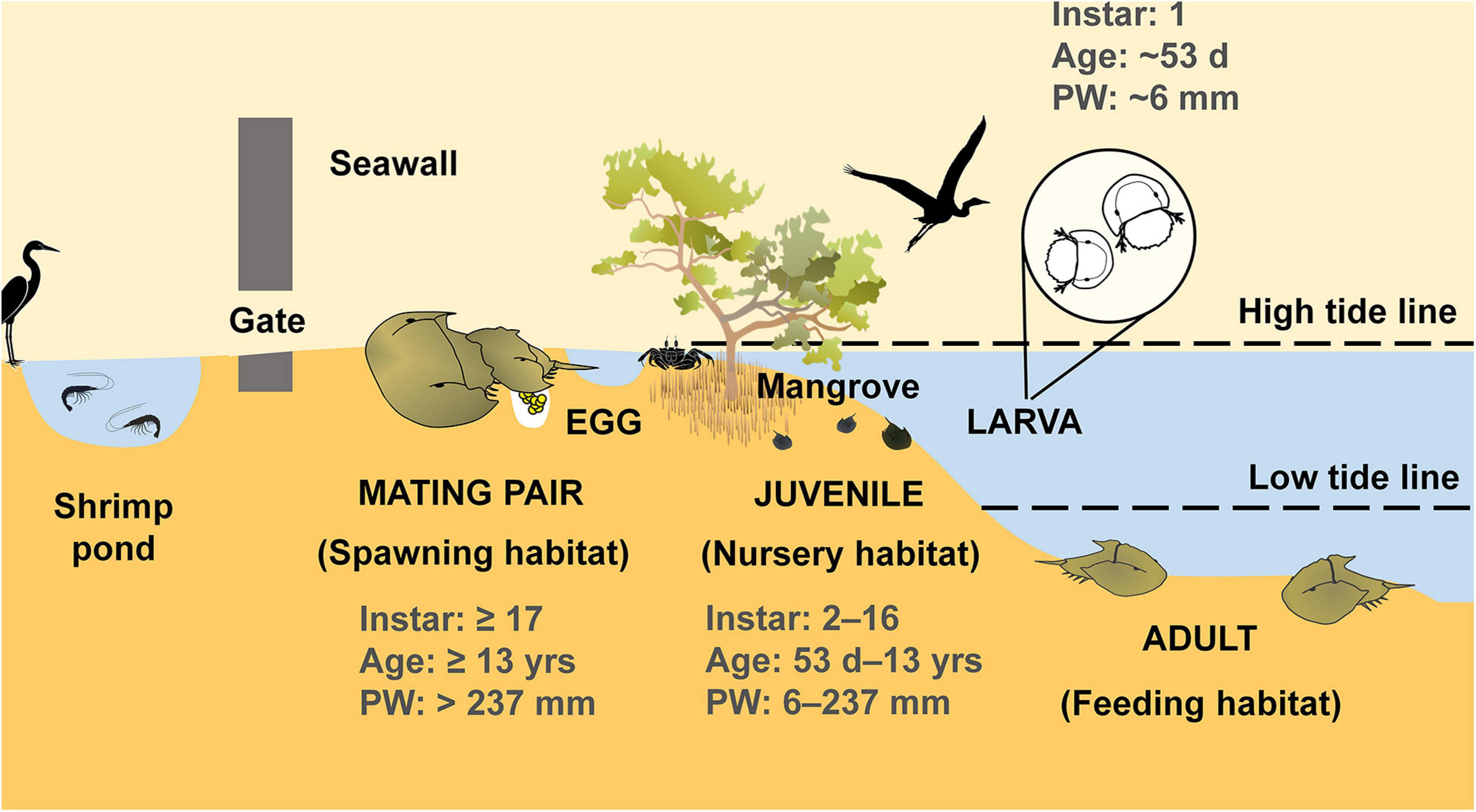 Frontiers Tri Spine Horseshoe Crab Aquaculture Ranching And Stock Enhancement Perspectives And Challenges Marine Science
Frontiers Tri Spine Horseshoe Crab Aquaculture Ranching And Stock Enhancement Perspectives And Challenges Marine Science
Limulus Polyphemus Atlantic Horseshoe Crab Reproduction


